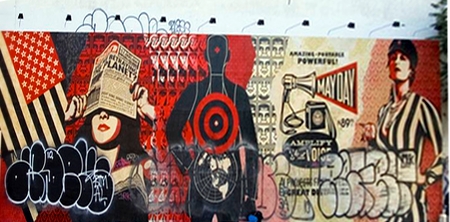
What's up with Americans' bifurcated view of graffiti? The chief of the NYPD is purportedly flipping out over Lewy BTM's 2012 tagging of the Brooklyn Bridge, and Los Angeles is prosecuting graffiti writers under anti-gang and anti-terrorism laws. But the LA Museum of Contemporary Art's 2011 Art in the Streets exhibition drew MOCA's greatest attendance to date; Banksy, Shepard Fairey, and Os Gemeos are becoming household names; and Banksy's Exit Through the Gift Shop won an Oscar. A bit surreal, but true: Shepard Fairey now has a popular fashion line, OBEY.
Is there a qualitative difference between the graffiti that the art world loves, and the more common tagging that city officials and much of the public equate with the urinary habits of canines? Can we legitimately divide graffiti writers into camps: the "vermin" and the "innovators"? That's a logical labyrinth, given that the common tagger engages in what the law calls destruction of property, and so does the graffiti "artist." The same act, the same medium, cannot be a repugnant act of vandalism in one person's hands, and an exemplar of human innovation in another's.

It's just as tricky to pin down aesthetic distinctions between common street-level work and "artistic" graffiti. Just as there are multiple forms of gallery art, there are multiple forms of graffiti -- all equally legitimate (or illegitimate, as the case may be). Just as abstract Dadaism may hang just around the corner from realist figure drawing in an art museum, unreadable-to-the-public tags appear on the same city block as larger-than-life graffiti murals. And just as it's hard to understand and deeply appreciate abstract art without substantial background knowledge, it takes an understanding of context and history -- even a lived lexical vocabulary -- to fully grasp the significance of back-alley tags as vibrant human expression.

A complicated irony weaves through all this. "Artisitic" graffiti works, really, only because of the graffiti that is widely condemned -- graffiti that city officials stolidly criminalize. The meaning and value of street-level graffiti are bound up in its rawness, its subversion of the medium, and the improbable odds of its successful creation. Lewy BTM's summer feat is viewed as sublime in this regard: painting three human-sized, filled-in renditions of his infamous moniker at one of the most legendary spots in the history of graffiti, all while keeping a cool head and dodging bridge guards on alert for terrorists. Understood in the proper light, the very process that produces work like this has its own incandescent quality and meaning. The brilliance of street-level graffiti is so potent that even consumer-ready graffiti basks in its glow, as if it were its own and not on loan from the street.
Compounding the irony is that this bifurcation mirrors many other features of contemporary culture. To promote broad consumption, it's common for vibrant artistic, intellectual and spiritual expressions to be toned down. As a philosopher I sense that my profession's now-requisite sheen can undercut my deeper and truer thinking on many matters. And my authentic expressions of faith simply are unwelcome at most religious institutions, even when those institutions are themselves supposed to be authentic expressions of faith.
As the commercial imagery of private corporations continues to dominate public spaces in a chilling infinite jest, consider the uncommissioned imagery of the street as space for thought and reflection about what has real value and bears authentic meaning. The expressions of street-level graffiti parallel other cultural artifacts that society once criminalized, but now lauds as intrinsic to human flourishing: philosophy, religion, and, well, art.